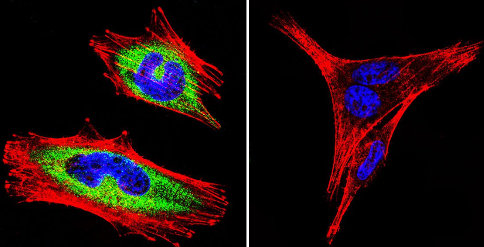
Immunocytochemistry/Immunofluorescence analysis of NCX1 shows staining in A2058 cells. NCX1 staining (green), F-Actin staining with Phalloidin (red) and nuclei with DAPI (blue) is shown. Cells were grown on chamber slides and fixed with formaldehyde prior to staining. Cells were incubated without (control) or with ab2869 (1:100) overnight at 4°C, washed with PBS and incubated with a DyLight-488 conjugated goat anti-mouse secondary antibody. Images were taken at 60X magnification.
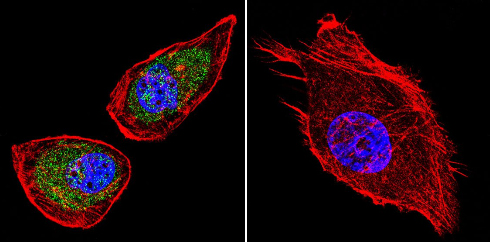
Immunocytochemistry/Immunofluorescence analysis of NCX1 shows staining in A549 cells. NCX1 staining (green), F-Actin staining with Phalloidin (red) and nuclei with DAPI (blue) is shown. Cells were grown on chamber slides and fixed with formaldehyde prior to staining. Cells were incubated without (control) or with ab2869 (1:100) overnight at 4°C, washed with PBS and incubated with a DyLight-488 conjugated goat anti-mouse secondary antibody. Images were taken at 60X magnification.
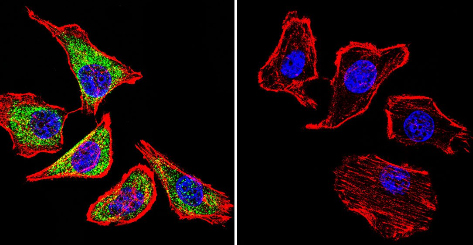
Immunocytochemistry/Immunofluorescence analysis of NCX1 shows staining in U251 cells. NCX1 staining (green), F-Actin staining with Phalloidin (red) and nuclei with DAPI (blue) is shown. Cells were grown on chamber slides and fixed with formaldehyde prior to staining. Cells were incubated without (control) or with ab2869 (1:100) overnight at 4°C, washed with PBS and incubated with a DyLight-488 conjugated goat anti-mouse secondary antibody. Images were taken at 60X magnification.
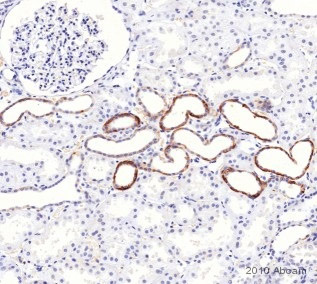
ab2869 staining NCX1 in Human kidney tissue sections by Immunohistochemistry (IHC-P - formaldehyde-fixed, paraffin-embedded sections). Tissue was fixed with formaldehyde, permeabilized with 0.05% Tween20 and blocked with 5% normal goat serum in 1XPBS + 0.05% Tween20 for 1 hour at 25°C; antigen retrieval was by heat mediation in sodium citrate (pH 6.0) buffer. Samples were incubated with primary antibody (1/100 in blocking buffer) for 1 hour at 25°C. Ab47827 (1/500) was used as the secondary antibody.See Abreview
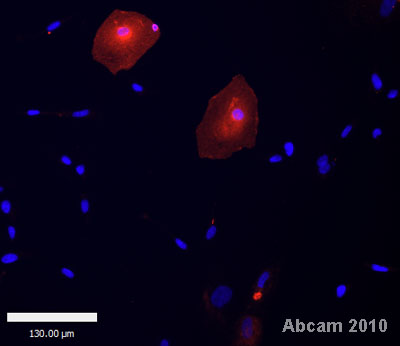
This image shows Human embryonic stem cell derived cardiomyocytes, stained with dapi (blue) and anti-NCX1 antibody ab2869 (red). The cells were fixed in paraformaldehyde, permeabilized with 0.1% Triton X-100 in PBS and blocked with 4% goat serum for 1 hour. The cells were then incubated with primary antibody (1/100) for 16 hours at 4°C.See Abreview
![Overlay histogram showing HEK293 cells stained with ab2869 (red line). The cells were fixed with 80% methanol (5 min) and then permeabilized with 0.1% PBS-Tween for 20 min. The cells were then incubated in 1x PBS / 10% normal goat serum / 0.3M glycine to block non-specific protein-protein interactions followed by the antibody (ab2869, 1/100 dilution) for 30 min at 22ºC. The secondary antibody used was DyLight® 488 goat anti-mouse IgM (mu chain) (ab97007) at 1/500 dilution for 30 min at 22ºC. Isotype control antibody (black line) was mouse IgM [ICIGM] (ab91545, 2µg/1x106 cells) used under the same conditions. Acquisition of >5,000 events was performed. This antibody gave a positive signal in HEK293 cells fixed with 4% paraformaldehyde (10 min)/permeabilized in 0.1% PBS-Tween used under the same conditions.](http://www.bioprodhub.com/system/product_images/ab_products/2/sub_3/28164_NCX1-Primary-antibodies-ab2869-6.jpg)
Overlay histogram showing HEK293 cells stained with ab2869 (red line). The cells were fixed with 80% methanol (5 min) and then permeabilized with 0.1% PBS-Tween for 20 min. The cells were then incubated in 1x PBS / 10% normal goat serum / 0.3M glycine to block non-specific protein-protein interactions followed by the antibody (ab2869, 1/100 dilution) for 30 min at 22ºC. The secondary antibody used was DyLight® 488 goat anti-mouse IgM (mu chain) (ab97007) at 1/500 dilution for 30 min at 22ºC. Isotype control antibody (black line) was mouse IgM [ICIGM] (ab91545, 2µg/1x106 cells) used under the same conditions. Acquisition of >5,000 events was performed. This antibody gave a positive signal in HEK293 cells fixed with 4% paraformaldehyde (10 min)/permeabilized in 0.1% PBS-Tween used under the same conditions.
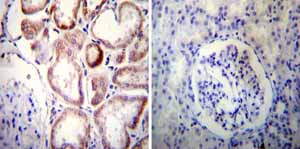
Immunohistochemistry was performed on both normal and cancer biopsies of deparaffinized Human kidney tissue tissues. To expose target proteins heat induced antigen retrieval was performed using 10mM sodium citrate (pH6.0) buffer microwaved for 8-15 minutes. Following antigen retrieval tissues were blocked in 3% BSA-PBS for 30 minutes at room temperature. Tissues were then probed at a dilution of 1:50 with a mouse monoclonal antibody recognizing Sodium/Calcium Exchanger ab2869 or without primary antibody (negative control) overnight at 4°C in a humidified chamber. Tissues were washed extensively with PBST and endogenous peroxidase activity was quenched with a peroxidase suppressor. Detection was performed using a biotin-conjugated secondary antibody and SA-HRP followed by colorimetric detection using DAB. Tissues were counterstained with hematoxylin and prepped for mounting.
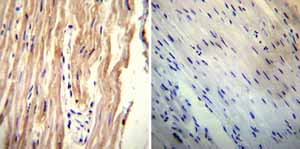
Immunohistochemistry was performed on both normal and cancer biopsies of deparaffinized Human heart tissue tissues. To expose target proteins heat induced antigen retrieval was performed using 10mM sodium citrate (pH6.0) buffer microwaved for 8-15 minutes. Following antigen retrieval tissues were blocked in 3% BSA-PBS for 30 minutes at room temperature. Tissues were then probed at a dilution of 1:20 with a mouse monoclonal antibody recognizing Sodium/Calcium Exchanger ab2869 or without primary antibody (negative control) overnight at 4°C in a humidified chamber. Tissues were washed extensively with PBST and endogenous peroxidase activity was quenched with a peroxidase suppressor. Detection was performed using a biotin-conjugated secondary antibody and SA-HRP followed by colorimetric detection using DAB. Tissues were counterstained with hematoxylin and prepped for mounting.





![Overlay histogram showing HEK293 cells stained with ab2869 (red line). The cells were fixed with 80% methanol (5 min) and then permeabilized with 0.1% PBS-Tween for 20 min. The cells were then incubated in 1x PBS / 10% normal goat serum / 0.3M glycine to block non-specific protein-protein interactions followed by the antibody (ab2869, 1/100 dilution) for 30 min at 22ºC. The secondary antibody used was DyLight® 488 goat anti-mouse IgM (mu chain) (ab97007) at 1/500 dilution for 30 min at 22ºC. Isotype control antibody (black line) was mouse IgM [ICIGM] (ab91545, 2µg/1x106 cells) used under the same conditions. Acquisition of >5,000 events was performed. This antibody gave a positive signal in HEK293 cells fixed with 4% paraformaldehyde (10 min)/permeabilized in 0.1% PBS-Tween used under the same conditions.](http://www.bioprodhub.com/system/product_images/ab_products/2/sub_3/28164_NCX1-Primary-antibodies-ab2869-6.jpg)

